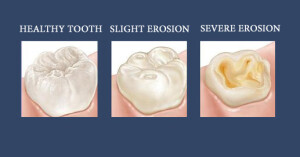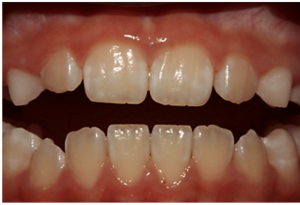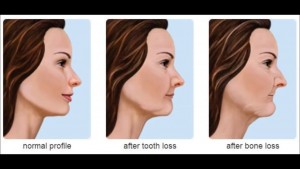Mouth breathing, as the name suggests, is breathing through the mouth rather than the nose. In majority of the cases, mouth breathing represents an involuntary adaptation to an obstructed nasal airway, and mouth breathing is a requirement simply in order to get enough air. This can be due to an obstruction in the nose or even adenoids. Chronic mouth breathing in children may result in damaging effects to dental and facial growth. It may cause gingivitis of the front teeth, bad breath and even movement of the front teeth. Treatment generally involves removal of the obstruction or a habit breaking appliance fabricated by the dentist.
Category Archives: General
Teething
Although newborns usually have no visible teeth, most start developing baby teeth between 4-7 months of age. Children usually have their full set of 20 primary teeth in place by age 3. As their teeth erupt, some babies may become fussy, sleepless and irritable, lose their appetite or drool more than usual. But diarrhoea, rashes and a fever are not normal for a teething baby. Your child may have sore or tender gums when teeth begin to erupt. Gently rubbing their gums with a clean finger, a small cool spoon,or a moist gauze pad can be soothing. Your doctor may recommend a pacifier. When your child’s teeth begin to come in, brush them gently with a child’s size toothbrush and water. For children between the ages of 2 and 6, brush their teeth with a pea-sized amount of fluoride toothpaste. Be sure they spit out the toothpaste. You should start regular dental check-ups for your child after their first tooth appears, but no later than their first birthday.
Erosion of the tooth Enamel
Erosion is the irreversible loss of tooth structure due to chemical dissolution by acids not of bacterial origin. Teeth are one of the hardest substances in the human body. However, sometimes due to our habits, we can cause damage to our teeth .Erosion of the tooth enamel is one of the many causes of tooth pain. Tooth erosion occurs when excess acid wears away the tooth enamel, which is the hard outer layer that gives teeth their structure and strength. In general, minerals in saliva helps neutralize the acid in the foods we eat and protect your tooth enamel from erosion. But if we consume a lot of highly acidic foods or drinks, we may be increasing our risk for tooth erosion. An eroded tooth can cause sensitivity to hot and cold, look discolored or even develop cracks or small dents on the chewing surface. To reduce this risk, keep acidic foods to a minimum, drink carbonated drinks using a straw, or chew sugar-free gum so that your mouth produces more saliva in order to recover from exposure to excess acid. In severe cases, your dentist might advise crowns in order to protect your teeth from further damage.
Dental fluorosis
Dental fluorosis is a cosmetic condition that affects teeth. It’s caused by overexposure to fluoride during the first eight years of life, when most permanent teeth are being formed. Flourosis can be associated with excessive fluoride levels in drinking water or sometimes inappropriate use of toothpastes or mouth rinses. Sometimes, children enjoy the taste of fluoridated toothpaste so much that they swallow it instead of spitting it out. The affected teeth by fluorosis may appear mildly discoloured that only dentists can detect.In more severe cases, the teeth may have stains ranging from yellow to dark brown, surface irregularities or pits that are highly noticeable and difficult to clean. This condition is not painful but can have a psychological effect on an individual due to its appearance. For mild cases, treatment might include teeth whitening or micro-abrasion. But in moderate to severe cases, veneers or crowns may be advised by the dentist.
Common myths and facts about dental
Myth:-Diet does not play a significant role in the development of tooth decay.
Fact:-Sugary food creates an acidic environment in the mouth, which is bad for tooth’s enamel. Dairy products such as cheese, yogurt, and real butter can protect the tooth’s enamel by creating an alkaline environment in the mouth.
Myth:-It’s not so important to brush baby tooth twice a day because they’ll fall out and be replaced by permanent teeth in a few years anyway.
Fact: – Baby teeth are the foundation of the permanent teeth. If they decay, the child can become more prone to having decay on permanent teeth as well. Decayed baby teeth can also cause early stage gum disease.
Myth:-Fruit juice is better for the teeth than soda.
Fact:-Fruit juice is actually worse than soda because it is even more acidic. Sipping on fruit juice throughout the day is therefore a big no-no if you want to keep your teeth healthy. Choose water instead.
Myth: Using sugarless chewing gum after meal can replace brushing
Fact: Nothing can replace proper brushing technique. And in case you want to use sugarless chewing gum do not chew it for more than 10 minutes.
Myth: Mouthwash can substitute tooth brushing.
Fact: No, mouthwash only helps in maintaining fresh breath for little time. It can’t clean food particles in between teeth. Nothing can substitute tooth brushing.
Peg lateral teeth
Peg lateral teeth, or peg lateral incisors, are terms used to describe a condition where the lateral incisors (the second tooth on either side of the front teeth) are undersized, conical and appear smaller than normal. This situation occurs when the permanent lateral incisors do not fully develop. Due to presence of peg lateral incisor, there will be a space between them and the adjacent teeth (this space normally would have been occupied by a fully developed lateral incisor) resulting in smile to appear abnormal.
There are several ways to treat and correct this condition. Porcelain veneers are the most common treatment for peg lateral incisors, and require little or no tooth preparation. A porcelain shell is simply bonded over the smaller peg laterals making the teeth appear normal in size. If not enough space exists, it can be created by orthodontic treatment.
Causes of Peg Lateral incisors :
There are two primary causes of peg laterals
- Genetics: there seems to be a genetic component to this condition. Some people with peg laterals have parents who had the same condition.
- Developmental anomaly: Sometimes the teeth just do not form correctly.
Some people are genetically missing the adult lateral incisors so the primary or baby lateral incisors remain in the position of the adult lateral incisors which looks abnormally small in an adult mouth.
How can we treat Peg Laterals :
(1) cosmetic bonding / Build up with tooth-colored materials
(2) Porcelain veneers
(3) Orthodontic treatment may be needed to position these teeth ideally for either of the above two options. We work with many talented orthodontists to assist us when necessary for a more ideal result for you!
Sometimes the only treatment needed is to re position the peg laterals with orthodontic treatment or a removable appliance.
Missing teeth can change face shape
If you have ever seen someone with missing teeth you may have noticed that their jaw has recessed, and their face could appear as if it’s sagging. Facial sagging due to bone loss and an absence of structure due to tooth loss is common. Even patients with traditional dentures may experience some degree of facial sagging.
Tooth and bone loss can actually change the form of your facial structure altering your overall look. Facial sagging will cause premature aging and may take a toll on a patient’s self-confidence. Tooth loss destabilizes the whole structure of the jaw. With an empty root socket, space is made and allow teeth to shift. Empty sockets also weaken the bone tissue and eventually results in the bone tissues breaking down and wearing.
How am i able to stop facial sagging if I actually have missing teeth?
Missing teeth can have psychological, functional and aesthetic consequences. Replacing missing teeth promptly once a loss is an optimal solution for preventing facial sagging. Dental implants are the most supportive treatment possibility for replacing missing teeth and promoting healthy bone structure. Dental implant secured dental restoration can facilitate rebuild your overall look.
DENTAL IMPLANT may be used to replace a single missing tooth or to secure a dental restoration for the replacement of the many missing teeth. Implants are the most natural possibility for restoring a smile with missing teeth. Dental implants will facilitate prevent facial sagging and help stabilize the integrity of the facial structure.
Supporting Facial Integrity after Tooth Loss
Replacing teeth with dental implants will stabilize the jaw bone preventing extra tooth loss, bone loss, and facial sagging. dental implant posts mimic the natural tooth root and really help regenerate healthy bone tissue. Dental implants are made from medical grade, biocompatible materials that fuse to the jaw making a stable and lasting bond.
Know more about a Flosser & its Types
Using a Flosser
If you don’t like reaching into the back of your mouth, or if you are helping a child or elderly parent with oral hygiene, a flosser may be the right product to meet your flossing needs. A flosser is, in simplest terms, a piece of dental floss on a handle. Many types of flossers are available, and any of them will help promote oral health when you use them properly to clean between and around teeth. Which flosser you choose comes down to personal preference, but look for a model with a long handle for easier holding and a compact head that makes it easier to reach behind the back teeth—a particularly tricky spot to clean.
Flosser Type Some flossers are totally disposable and others have disposable, refillable heads. You can also buy flossers that have specially designed handles with no-slip grips to make them even easier to hold. Some flossers have an area that works as a tongue scraper, and others come in small sizes with child-friendly designs.
Ugly Duckling Phase
The ugly duckling stage, occurs during the mixed dentition phase (when both milk and permanent teeth are present in the mouth) of tooth eruption between the ages of 7-12 years. It is a stage of dental development that occurs during the eruption of the permanent canine, in which the lateral incisors become tilted because the erupting canines impinge on the roots of the incisors. It is called ugly duckling stage because dentition in children at this stage looks very ugly due to multiple spacing between their teeth. This is a self-correcting condition and requires no treatment or cause for concern. However, check-ups at regular intervals is necessary to rule out the possibility of crowding and if crowding is suspected, growth modification appliances can be prescribed by the dentist.
Tooth Erosion
Tooth erosion is the wearing away of tooth enamel by acid. The enamel is the hard calcified tissue that covers and protects the outside of the tooth. It is also the hardest substance in our bodies.
Symptoms of tooth erosion can range from sensitivity to more severe problems such as cracking. Be sure to let your dentist know if you experience any symptoms of tooth erosion.
Early Symptoms of Tooth Erosion
- Discoloration – Since the dentin of the tooth is exposed during tooth erosion, discoloration or yellowing of the teeth can occur.
The more dentin that is exposed, the more yellow the teeth will become. - Tooth Sensitivity – Sensitive teeth are very common symptoms of tooth erosion because the enamel that protects the teeth wears away, leaving exposed dentin.
- Rounded Teeth – During the early stages of tooth erosion, it is common for teeth to have a rounded look.
- Transparent or Sand Blasted Appearance – It is not uncommon in the early stages of tooth erosion for the teeth to have a sand blasted look or for the tips of the front teeth to look transparent.
Advanced and Severe Symptoms of Tooth Erosion
- Cracking – If tooth erosion continues into the advanced stage, the edges of the teeth can start to crack and have a rough feeling.
- Dents – Little dents, also called cupping, can start to appear on the biting areas of the teeth.
- Extreme Sensitivity – Since the enamel wears away during tooth erosion, the teeth can become extremely sensitive during the advanced stages of tooth erosion.













